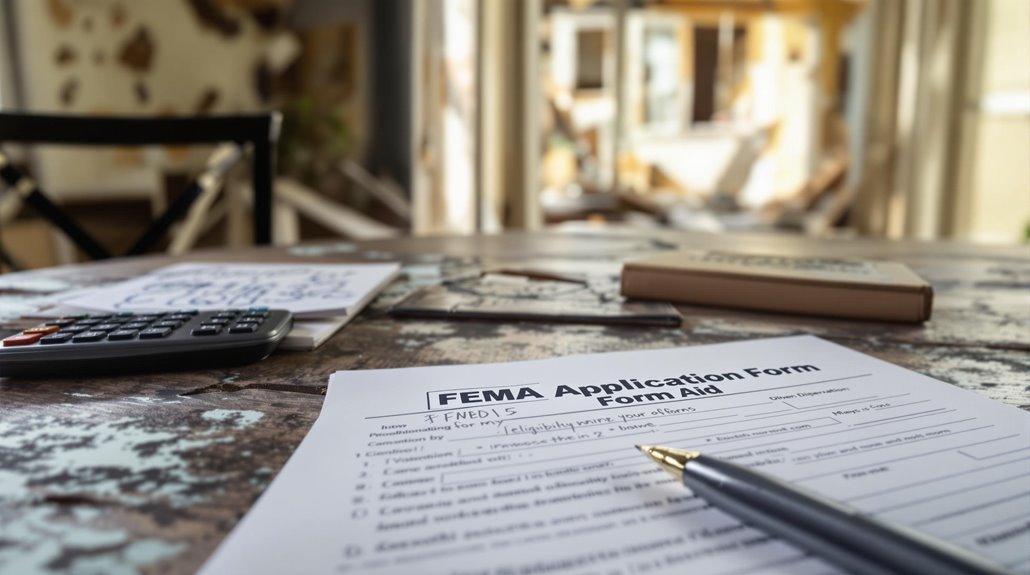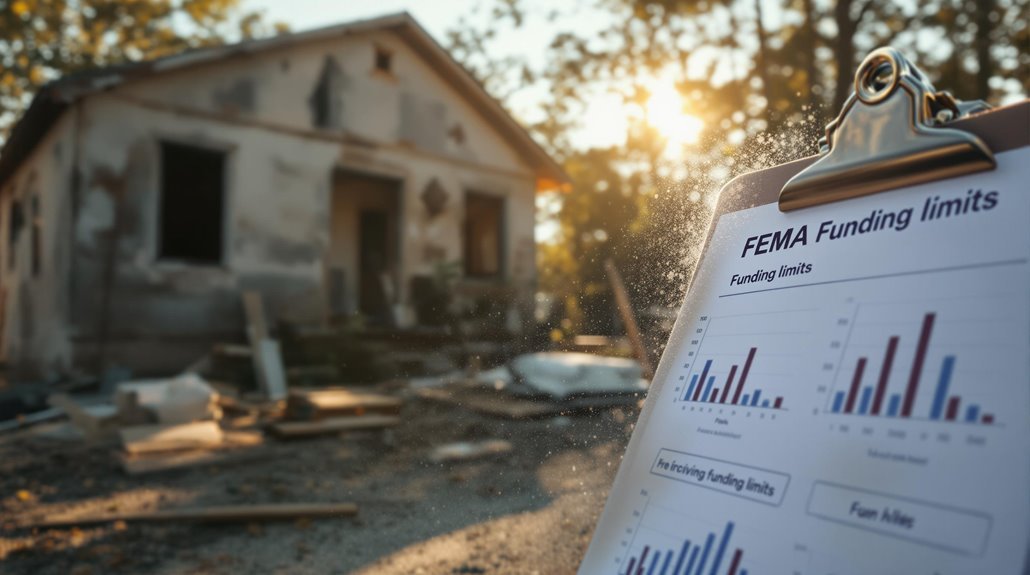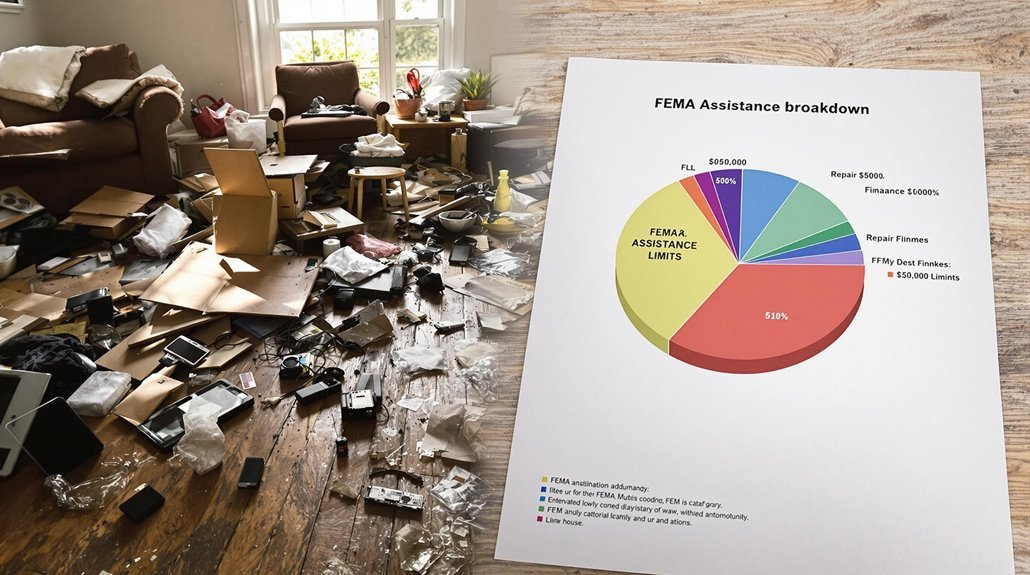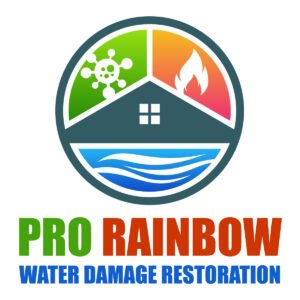FEMA can pay up to $36,000 for home repairs under the Individual Assistance program, designed for crucial fixes after disasters. Nevertheless, the maximum grant amount for repair assistance may vary based on federal budgets and specific disaster declarations. You must demonstrate that the damage resulted from the declared disaster and show that your insurance doesn't cover all repair costs. Furthermore, temporary housing and expenses can receive up to $34,000. Understanding these limits helps you navigate the application process effectively. With a clearer grasp of these figures, you'll better prepare your recovery strategy for future challenges.
Key Takeaways
- The maximum grant amount for FEMA's Individual Assistance program is $37,900 per household for disaster-related repairs and housing costs.
- Homeowners can typically receive up to $36,000 specifically for essential home repairs after a disaster.
- FEMA assistance covers only necessary repairs; not all damage types are eligible for funding.
- Insufficient insurance coverage must be demonstrated to qualify for repair assistance from FEMA.
- Applications for repair assistance must be submitted within a designated timeframe after the disaster declaration.
Overview of FEMA Assistance

When disaster strikes, understanding the overview of FEMA assistance can be vital for recovery. FEMA funding plays a key role in helping individuals and communities rebuild after a disaster. This federal support is designed to address immediate needs, such as temporary housing and critical repairs. FEMA's assistance aims to restore your home and provide resources for long-term recovery. It's important to recognize that this funding is not limitless; it comes with specific eligibility criteria and financial caps. Knowing the guidelines can help you navigate the application process effectively. By familiarizing yourself with FEMA assistance, you can better prepare for the steps ahead and guarantee that you maximize the support available during your disaster recovery journey. Additionally, understanding emergency water removal services can further aid in your recovery process by minimizing damage immediately after a disaster.
Types of FEMA Assistance Programs
Understanding the various types of FEMA assistance programs can greatly impact your recovery process after a disaster. FEMA offers several key programs to help you get back on your feet. The Individual Assistance program provides financial help through FEMA grants, covering vital repairs and temporary housing costs. Public Assistance focuses on helping local governments and non-profits restore damaged infrastructure, while the Hazard Mitigation Grant Program funds projects aimed at reducing future disaster risks. Moreover, the National Flood Insurance Program (NFIP) offers coverage for flood-related damages. Knowing these options allows you to navigate disaster assistance effectively and guarantees you receive the support necessary for your recovery. Familiarize yourself with these programs to optimize your aid experience. Additionally, understanding water damage restoration can help you assess the necessary repairs and services you might need after an incident.
Eligibility Requirements for Aid

To qualify for FEMA aid, you must meet specific eligibility requirements that vary depending on the type of assistance you're seeking. Generally, you need to have experienced a disaster that's declared by the president, and you must be a U.S. citizen, non-citizen national, or qualified alien. For FEMA grants focused on disaster recovery, your primary residence must be in the affected area, and you should demonstrate your need for assistance. It's vital to provide accurate information and documentation about your losses, as this influences your eligibility. Furthermore, you must apply within a designated timeframe following the disaster declaration. Understanding these requirements can greatly improve your chances of receiving the help you need for recovery.
Individual Assistance Program Limits
When you apply for FEMA's Individual Assistance Program, it's essential to understand the maximum grant amounts and what repair costs are eligible. These limits can greatly influence your recovery, so knowing them upfront helps you plan effectively. Let's investigate how these financial boundaries shape the support you can receive.
#
Maximum Grant Amounts
The Individual Assistance Program offers a maximum grant amount of $37,900 for eligible households affected by disasters. This funding is vital for recovery, helping you get back on your feet. Understanding the limits of FEMA funding and the grant distribution process can empower you to make knowledgeable choices about your recovery.
- The grant amount is designed to cover key repairs and temporary housing.
- It's important to note that this maximum is subject to change based on federal budget allocations and disaster declarations.
- Applicants must provide documentation to prove eligibility, ensuring that funds are distributed fairly.
Eligible Repair Costs
While traversing the Individual Assistance Program, understanding what constitutes eligible repair costs is vital for maximizing your grant benefits. Eligible repair types typically include structural repairs to your home, such as fixing roofs, windows, or floors. You can additionally claim costs for important utilities like electrical systems, plumbing, and heating. Nevertheless, it's important to stay within the repair cost limits set by FEMA. These limits can vary based on your specific situation and the extent of damage. Make sure to document all expenses and obtain estimates before proceeding with repairs. By knowing which repairs qualify and adhering to cost limits, you can effectively utilize FEMA's assistance to restore your home after a disaster.
Home Repair Assistance Criteria

When you apply for FEMA home repair assistance, understanding the eligibility requirements is essential. You'll need to know the maximum assistance amounts available and the specific types of repairs that qualify for funding. This knowledge can greatly impact your recovery process and guarantee you get the help you need.
Eligibility Requirements Explained
To qualify for FEMA repair payments, you must meet specific eligibility requirements that guarantee assistance is directed to those in genuine need. Understanding these eligibility criteria is essential to accessing FEMA assistance effectively. Here are some key factors to take into account:
- You must be a homeowner or renter in a declared disaster area.
- Your home must have sustained damage as a result of a disaster, such as flooding or hurricanes.
- You need to demonstrate that you have insufficient insurance coverage to cover repair costs.
Meeting these criteria guarantees that you're in line for potential FEMA assistance, helping you recover from disaster-related damages efficiently. Be sure to gather all necessary documentation to support your application.
Maximum Assistance Amounts
Once you've confirmed your eligibility for FEMA repair payments, it's important to understand the maximum assistance amounts available for home repair. FEMA typically offers a maximum grant of $36,000 for vital repairs to restore your home to a safe living condition. This amount is part of a broader disaster recovery strategy aimed at helping individuals regain stability after a disaster. Keep in mind that this maximum grant can cover various repairs, but it may not fully address extensive damage. As a result, evaluating your specific needs and documenting all repairs is significant for maximizing your benefits. Understanding these limits can help you plan your recovery effectively and guarantee you receive the assistance you're entitled to.
Types of Eligible Repairs
Understanding the types of eligible repairs can greatly influence the effectiveness of your FEMA assistance. FEMA's funding breakdown for home repair assistance typically covers various repair types crucial for restoring your home's safety and habitability. Here's what you should know:
- Structural Repairs: This includes fixing damage to walls, roofs, and foundations, ensuring your home remains structurally sound.
- Utilities Restoration: Repairs to electrical, plumbing, and HVAC systems fall under this category, making your home functional.
- Severe Weather Damage: FEMA often funds repairs specifically related to storm, flood, or hurricane damage, addressing the aftermath of natural disasters.
## Maximum Grant Amounts
While maneuvering through the complexities of FEMA repair payments, it's crucial to know the maximum grant amounts available to you. FEMA funding provides critical support for homeowners and renters affected by disasters, primarily through repair grants. Currently, the maximum grant amount for housing assistance is $37,900, which can cover various eligible repair costs. Remember, this amount may vary based on individual circumstances and the extent of the damage. Furthermore, there's a cap on personal property assistance, set at $34,900, allowing you to replace necessary items lost or damaged. Understanding these limits guarantees you can effectively navigate your financial recovery, making knowledgeable choices as you work toward restoring your home.
Temporary Housing Assistance

When you're facing temporary displacement after a disaster, understanding the eligibility criteria for Temporary Housing Assistance is essential. You'll want to be aware of the payment limits and how they apply to your situation. Guiding through the application process efficiently can help you secure the support you need during this challenging time.
Eligibility Criteria Explained
To qualify for Temporary Housing Assistance through FEMA, you must meet specific eligibility criteria that reflect your immediate needs after a disaster. Understanding these FEMA eligibility requirements is essential for securing aid. Here are some key aid qualifications you should consider:
- You must have a primary residence that's been damaged or destroyed as a result of a declared disaster.
- You need to demonstrate that you have no other housing options available, compelling you to seek temporary assistance.
- Your application must be submitted within 60 days of the disaster declaration to guarantee timely processing.
Payment Limits Overview
Understanding the payment limits for Temporary Housing Assistance through FEMA is vital for disaster survivors seeking support. FEMA funding aims to help you secure temporary housing when your home becomes uninhabitable as a result of disasters. Nevertheless, it's important to recognize the repair limitations that accompany this assistance. Typically, FEMA caps payments for temporary housing at a maximum of $34,000 for eligible households, but this amount can vary based on individual circumstances and the extent of damage. Furthermore, the assistance is often available for a limited duration, often up to 18 months. Knowing these limits helps you plan your recovery effectively and make educated choices about your temporary living arrangements while you navigate the repair process.
Application Process Steps
As you navigate the application process for Temporary Housing Assistance through FEMA, knowing the essential steps can streamline your efforts and increase your chances of receiving support. Start by gathering the required documents, as missing paperwork can delay your application. Here are some application tips to help you succeed:
- Proof of identity: Include a government-issued ID or Social Security number.
- Disaster-related documents: Gather any notices, reports, or claims related to your disaster situation.
- Financial information: Prepare details about your income and expenses to demonstrate need.
Once you have everything ready, submit your application online, by phone, or in person. Keep track of your application status and be prepared for any follow-up requests from FEMA.
Additional Living Expenses Coverage
While maneuvering the aftermath of a disaster, securing Additional Living Expenses (ALE) coverage can greatly ease the financial burden of temporary relocation. This coverage helps you offset additional expenses related to housing, meals, and other necessities when your home becomes uninhabitable. FEMA typically provides ALE for a limited time, so it's vital to act quickly and document all costs incurred during your displacement. By understanding the specifics of your ALE coverage, you can effectively manage your living assistance needs while awaiting repairs. Keep in mind that ALE is not meant for long-term solutions but rather to support you through the immediate aftermath. Knowing these details can empower you to make educated choices during a challenging time.
Personal Property Assistance Limits

Personal property assistance through FEMA can greatly reduce the stress of replacing vital items after a disaster. Nonetheless, it's important to comprehend the assistance limits that apply to personal property claims. Typically, FEMA covers personal property losses up to a specific dollar amount, which might not fully replace all your items.
Here are some key points to take into account:
- Eligibility: You must meet certain eligibility criteria to qualify for personal property assistance.
- Documentation: Providing detailed documentation of your losses can help maximize your claim.
- Replacement Costs: FEMA usually covers the cost of replacing critical items, but limits may vary based on your situation.
Understanding these personal property assistance limits helps you navigate the recovery process effectively.
Appeals Process for Denied Claims
After maneuvering the limits of personal property assistance, you might find yourself facing a denied claim. Fortunately, the FEMA appeal process allows you to challenge that decision. First, carefully review the denial letter; it often contains reasons for the decision. Next, gather supporting documents, including photographs, receipts, and any relevant correspondence. Within 60 days of receiving the denial, you'll need to submit a written appeal outlining why you believe the claim should be approved. Clearly articulate your case and include all necessary documentation to bolster your argument. Keep copies of everything you send. If you follow these steps, you'll improve your chances of successfully overturning denied claims and securing the assistance you need.
Common Misconceptions About FEMA

Many people hold misconceptions about FEMA and its role in disaster relief, which can lead to confusion and frustration during the recovery process. Understanding these FEMA myths is vital for effective disaster recovery. Here are some common misconceptions:
- FEMA pays for all types of damage: Only necessary repairs are covered; personal property losses often aren't.
- You must be uninsured to qualify: Regardless of having insurance, FEMA can assist with uncovered costs.
- FEMA assistance is unlimited: There are strict limits on the amount of aid available, depending on the type of assistance.
Resources for Further Information
When maneuvering through the complexities of FEMA repair payments, it's essential to have access to reliable resources that can provide accurate information and guidance. The official FEMA website is a primary source for information on FEMA funding, offering thorough details about eligibility, application processes, and payment limits. You can likewise find localized resources through state emergency management agencies, which can help you navigate disaster recovery specific to your area. Furthermore, nonprofit organizations like the American Red Cross provide valuable support and information on available assistance. Engaging with local community centers can similarly yield insights from individuals who've experienced similar situations. Utilizing these resources guarantees you stay informed and make the most of your FEMA benefits.
Conclusion
To summarize, understanding FEMA's assistance limits is essential for maneuvering the recovery process after a disaster. Did you know that, on average, FEMA provides around $8,000 per household for home repairs? This figure highlights the importance of knowing what's covered and what isn't. By familiarizing yourself with the eligibility requirements and specific program limits, you can better prepare for any potential aid you might need. Stay informed to make the most of the resources available to you.




